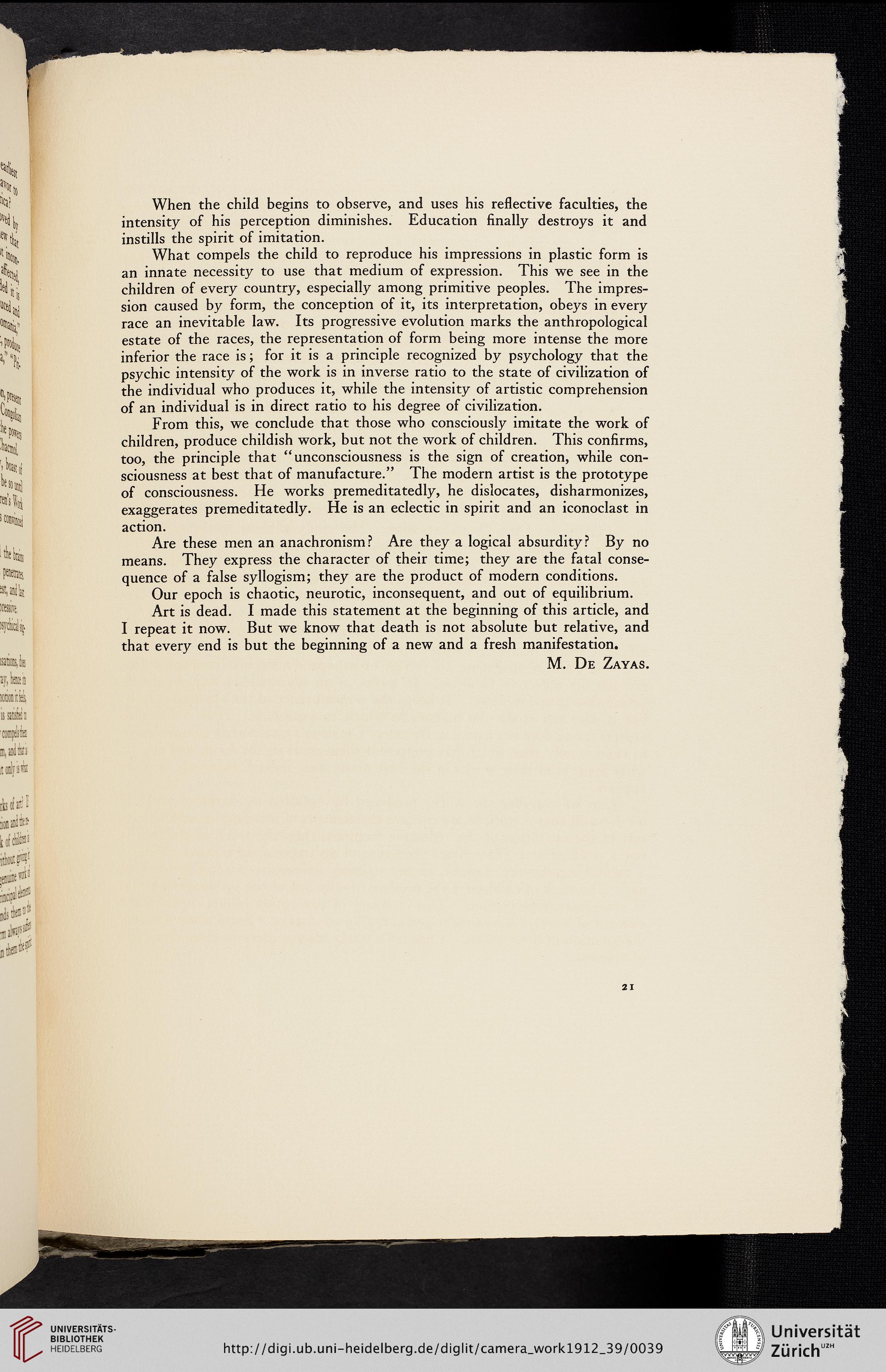Für diese Seite ist auch eine manuell angefertigte Transkription bzw. Edition verfügbar. Bitte wechseln Sie dafür zum Reiter "Transkription" oder "Edition".
When the child begins to observe, and uses his reflective faculties, the
intensity of his perception diminishes. Education finally destroys it and
instills the spirit of imitation.
What compels the child to reproduce his impressions in plastic form is
an innate necessity to use that medium of expression. This we see in the
children of every country, especially among primitive peoples. The impres-
sion caused by form, the conception of it, its interpretation, obeys in every
race an inevitable law. Its progressive evolution marks the anthropological
estate of the races, the representation of form being more intense the more
inferior the race is; for it is a principle recognized by psychology that the
psychic intensity of the work is in inverse ratio to the state of civilization of
the individual who produces it, while the intensity of artistic comprehension
of an individual is in direct ratio to his degree of civilization.
From this, we conclude that those who consciously imitate the work of
children, produce childish work, but not the work of children. This confirms,
too, the principle that “unconsciousness is the sign of creation, while con-
sciousness at best that of manufactured The modern artist is the prototype
of consciousness. He works premeditatedly, he dislocates, disharmonizes,
exaggerates premeditatedly. He is an eclectic in spirit and an iconoclast in
action.
Are these men an anachronism? Are they a logical absurdity? By no
means. They express the character of their time; they are the fatal conse-
quence of a false syllogism; they are the product of modern conditions.
Our epoch is chaotic, neurotic, inconsequent, and out of equilibrium.
Art is dead. I made this statement at the beginning of this article, and
I repeat it now. But we know that death is not absolute but relative, and
that every end is but the beginning of a new and a fresh manifestation.
M. De Zayas.
intensity of his perception diminishes. Education finally destroys it and
instills the spirit of imitation.
What compels the child to reproduce his impressions in plastic form is
an innate necessity to use that medium of expression. This we see in the
children of every country, especially among primitive peoples. The impres-
sion caused by form, the conception of it, its interpretation, obeys in every
race an inevitable law. Its progressive evolution marks the anthropological
estate of the races, the representation of form being more intense the more
inferior the race is; for it is a principle recognized by psychology that the
psychic intensity of the work is in inverse ratio to the state of civilization of
the individual who produces it, while the intensity of artistic comprehension
of an individual is in direct ratio to his degree of civilization.
From this, we conclude that those who consciously imitate the work of
children, produce childish work, but not the work of children. This confirms,
too, the principle that “unconsciousness is the sign of creation, while con-
sciousness at best that of manufactured The modern artist is the prototype
of consciousness. He works premeditatedly, he dislocates, disharmonizes,
exaggerates premeditatedly. He is an eclectic in spirit and an iconoclast in
action.
Are these men an anachronism? Are they a logical absurdity? By no
means. They express the character of their time; they are the fatal conse-
quence of a false syllogism; they are the product of modern conditions.
Our epoch is chaotic, neurotic, inconsequent, and out of equilibrium.
Art is dead. I made this statement at the beginning of this article, and
I repeat it now. But we know that death is not absolute but relative, and
that every end is but the beginning of a new and a fresh manifestation.
M. De Zayas.



